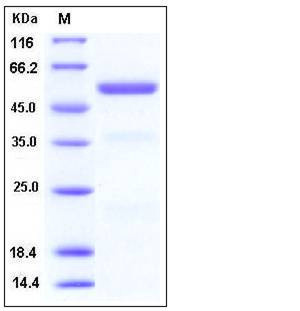Human Carboxypeptidase E / CPE Protein (His Tag)
CPE
- 100ug (NPP1972) Please inquiry
| Catalog Number | P10069-H08H |
|---|---|
| Organism Species | Human |
| Host | Human Cells |
| Synonyms | CPE |
| Molecular Weight | The recombinant human CPE comprises 439 amino acids and predicts a molecular mass of 49.4 kDa. As a result of glycosylation, the apparent molecular mass of rhCPE is approximately 53 kDa in SDS-PAGE under reducing conditions. |
| predicted N | Glu 26 |
| SDS-PAGE |  |
| Purity | > 90 % as determined by SDS-PAGE |
| Protein Construction | A DNA sequence encoding the human carboxypeptidase E (CPE) precursor (NP_001864.1) (Met 1-Ser 453) was fused with a polyhistidine tag at the C-terminus. |
| Bio-activity | Measured by its ability to cleave a peptide substrate, benzoyl-AR-OH. The product, Arg, reacted with orthophthaldialdehyde (OPA) to form a fluorescent molecule . The specific activity is >12,000 pmoles/min/μg. |
| Research Area | Signaling |Signal Transduction |Cytoskeleton / ECM |Cytoskeletal Proteins |Regulation |
| Formulation | Lyophilized from sterile PBS, pH 7.4 1. Normally 5 % - 8 % trehalose, mannitol and 0.01% Tween80 are added as protectants before lyophilization. Specific concentrations are included in the hardcopy of COA. |
| Background | Human carboxypeptidase E (CPE), also known as Carboxypeptidase H, is a peripheral membrane protein and a zinc metallocarboxypeptidase, and the conversion of proCPE into CPE occurs primarily in secretory vesicles. The active form of CPE cleaves C-terminal amino acid residues of the peptide, and is thus involved in the biosynthesis of peptide hormones and neurotransmitters including insulin, enkephalin, etc. The enzymatic activity is enhanced by millimolar concentrations of Co2+. It has also been proposed that membrane-associated carboxypeptidase E acts as a sorting receptor for targeting regulated secretory proteins which are mostly prohormones and neuropeptides in the trans-Golgi network of the pituitary and in secretory granules into the secretory pathway.Its interaction with glycosphingolipid-cholesterol rafts at the TGN facilitates the targeting. Mutations in this gene are implicated in type I I diabetes due to impaired glucose clearance and insulin resistance. |
| Reference |
